Influence of the Bearing Thermal Deformation on Nonlinear Dynamic Characteristics of an Electric Drive Helical Gear System
Abstract
:1. Introduction
2. Thermal Deformation of Deep Groove Ball Bearings in the High Speed Electric Drive System
2.1. Statics Analysis and Geometric Deformation Relationship of a Deep Groove Ball Bearing
2.2. Quasi-Statics Analysis of the High Speed Running Bearing and Its Deformation Geometry Equation
2.3. Calorific Value Calculation Model of the Deep Groove Ball Bearing Running at the High Speed
2.4. Temperature Rise and Thermal Deformation of the Bearing Based on the Thermal Resistance Network Method
- (1)
- The heat transfer process of the bearing is steady;
- (2)
- (3)
- The influence of temperature rise on the lubricating oil performance is ignored;
- (4)
- The flow rate of the cooling fluid is large enough so that the fluctuating temperature of the fluid is not considered, and the temperature of the oil–gas mixture is assumed to be fixed at 28 °C;
- (5)
- The material of all parts is assumed to be isotropic.
3. Analysis on the Influence of Bearing Stiffness on the Nonlinear Dynamic Characteristics of the Gear Transmission System
3.1. Calculation of Bearing Stiffness under the Thermal Deformation Condition
3.2. Dynamic Modeling of the High Speed Electric Drive Gear Transmission System
3.3. Analysis of Nonlinear Dynamic Characteristics of the Helical Gear Transmission System
4. Conclusions
- (1)
- Under the condition of high speed working condition, the thermal deformation of the bearing will occur in both the axial and radial directions. The axial thermal deformation is far less than the axial deformation, but the radial thermal deformation is close to the bearing radial deformation under loading. When considering the thermal deformation of the bearing, the axial stiffness of the bearing is reduced, while the radial stiffness increases.
- (2)
- The gear system of high speed electric drive appears T-periodic and chaotic motions under both accelerating and decelerating conditions. Under the accelerating condition, the system has a hopping point around 10,000 rpm, and it exhibits the 2T-periodic motion without considering the thermal deformation, while the rotational speed range of the system with the 2T-periodic motion is large when considering the thermal deformation. The system will have a spike step before the rotating speed of 7000 rpm under the decelerating condition, and there is one hopping point under the bearing stiffness without considering the thermal deformation. On the contrary, the system has two spikes under the bearing stiffness considering the influence of thermal deformation.
- (3)
- In accelerating and decelerating conditions, the bifurcation behavior of the system with the constant bearing stiffness is better than that with variable bearing stiffness values within the range of medium and high speed. The bifurcation characteristics of the system without considering the thermal deformation are more complicated than that considering the influences of the thermal deformation, but the extra chaotic motions of the system will appear when considering the thermal deformation in the medium speed range (about 11,150−11,250 r/min), which shows that the bearing stiffness may change the nonlinear dynamic characteristics of the system. Therefore, the influence of thermal deformation on bearing stiffness should be considered in the dynamic analysis of the high speed electric drive helical gear system.
Author Contributions
Funding
Institutional Review Board Statement
Informed Consent Statement
Data Availability Statement
Acknowledgments
Conflicts of Interest
Nomenclature
| Γ | Complete elliptic integral of the first kind |
| Π | Complete elliptic integral of the second kind |
| κ | Ellipticity parameter |
| α0 | Free contact angle of bearing (rad) |
| α | mounted contact angle (rad) |
| δ | Relative displacement or elastic deformation of contact (mm) |
| δn | Contact deformation between teeth (m) |
| θ | The angle of bearing under the action of external force (rad) |
| ψ | Position angle of ball (rad) |
| v | Poisson’s ratio |
| Es | Modulus of elasticity (Mpa) |
| ρb | Density of ball (kg/mm3) |
| ρ | Density of gear (kg/m3) |
| ωc | Rotational speed refers to orbital motion (rad/s) |
| μ | Lubricant kinematic viscosity (centistokes) |
| μs | Friction coefficient between ball and raceway |
| ω | The relative angular speed (rad/s) |
| ωsi | Spinning motion of ball relative to the outer raceway (rad/s) |
| ωso | Spinning motion of ball relative to the outer raceway (rad/s) |
| ωn | The absolute angular speed of the inner raceway (rad/s) |
| ωb | Spinning speed of ball (rad/s) |
| β | Attitude angle (rad) |
| βg | Gear helix angle (rad) |
| φ | The angle between the acting surface and vertical direction (rad) |
| θp | Rotation angle of driving gear (rad) |
| θg | Rotation angle of driven gear (rad) |
| A1 | The axial distance between the loci of inner and outer raceway groove curvature center (mm) |
| A2 | The radial distance between the loci of outer and outer raceway groove curvature center (mm) |
| A | Semimajor axis of projected contact ellipse (mm) |
| a | Thermal coefficient of expansion (1/°C) |
| B | Width of the inner ring (mm) |
| Bf | Total curvature |
| b | Backlash (m) |
| C | Width of the outer ring (mm) |
| cm | Gear meshing damping (N.s/m) |
| cb | Bearing damping coefficients (N.s/m) |
| Dh | The distance of the bearing seat from the center line of the shaft (mm) |
| Dm | Pitch diameter of bearing (mm) |
| D | Diameter (mm) |
| d | Raceway diameter (mm) |
| e | Integrated meshing error of gear pair (mm) |
| fi | Curvature coefficient |
| f0 | A factor depending on the type of bearing and the method of lubrication |
| F | Applied force on bearing (N) |
| Fc | Centrifugal force (N) |
| Fn | Meshing force of gear pair (N) |
| H | Power (W) |
| h | Convective heat transfer coefficient (W/mm2/°C) |
| I | Moment of inertia (kg.m2) |
| Jb | Mass moment of inertia of ball (kg.mm2) |
| K | Load-deflection constant (N/mm1.5) |
| k | Thermal conductivity (W/mm/°C) |
| kv | Thermal conductivity of lubrication oil (W/mm/°C) |
| Ka | Axial stiffness of bearing (N/mm) |
| Kr | Radial stiffness of bearing (N/mm) |
| kbpx | Bearing stiffness of bearing used to support driving gear (N/m) |
| kbgx | Bearing stiffness of bearing used to support driven gear (N/m) |
| km | Meshing stiffness of gear pair (N.m) |
| Ls | Distance between the node Ts from the transmission shaft end (mm) |
| Lh | Height of bearing housing (mm) |
| Mg | Gyroscopic moment (N.mm) |
| Mμ | Bearing friction torque due to lubrication (N.mm) |
| M1 | Bearing friction torque due to load (N.mm) |
| Ms | Spinning friction moment (N.mm) |
| m | Quality (kg) |
| n | Rotation speed of bearing (r/min) |
| nv | One third of the speed of the cage (m/s) |
| Pγ | Prandtl number |
| Q | Ball normal load (N) |
| Qr | Radial direction load on ball (N) |
| Qa | Axial direction load on ball (N) |
| Rr | Radius to locus of raceway groove curvature centers (mm) |
| Rb | Gear base radius (m) |
| R | Thermal resistant between nodes (°C/W) |
| r | Radius of curvature (mm) |
| T | Temperature of node (°C) |
| Ta | Temperature of air (°C) |
| t | Torque applied on gear (Nm) |
| uT | Radial thermal deformation (mm) |
| uTi’ | Radial thermal deformation of inner ring (mm) |
| uTo’ | Radial thermal deformation of outer ring (mm) |
| uTri | Radial thermal deformation of inner raceway considering thermal deformation of shaft (mm) |
| uTro | Radial thermal deformation of outer raceway considering thermal deformation of bearing seat (mm) |
| uTr | The relative radial thermal deformation between inner and outer raceway considering thermal deformation of ball (mm) |
| ua | The relative axial thermal deformation between the inner and outer raceway (mm) |
| uall | Composite deformation (mm) |
| X1 | Axial projection of distance between ball center and outer raceway groove curvature center (mm) |
| X2 | Radial projection of distance between ball center and outer raceway groove curvature center (mm) |
| Zb | Number of balls |
| Subscripts | |
| a | Axial direction |
| r | Radial direction |
| b | Ball |
| n | Normal direction |
| i | Inner ring or raceway |
| o | Outer ring or raceway |
| ci | Contact point between inner ring and transmission shaft |
| co | Contact point between outer ring and bearing seat |
| j | The jth |
| s | Transmission shaft |
| h | Bearing seat |
| p | Driving gear |
| g | Driven gear |
| x | Refers to x direction |
| y | Refers to y direction |
| z | Refers to z direction |
| og | gas–oil |
| Abbreviations | |
| NVH | noise: vibration, and harshness |
| TVMS | The time-varying meshing stiffness |
References
- Chen, H.; Jiang, B.; Ding, S.X.; Huang, B. Data-Driven Fault Diagnosis for Traction Systems in High-Speed Trains: A Survey, Challenges, and Perspectives. IEEE Trans. Intell. Transp. Syst. 2020, 1–17. Available online: http://ieeexplore.ieee.org/stamp/stamp.jsp?tp=&arnumber=9237134 (accessed on 17 December 2020).
- Chen, H.; Jiang, B. A Review of Fault Detection and Diagnosis for the Traction System in High-Speed Trains. IEEE Trans. Intell. Transp. Syst. 2020, 21, 450–465. [Google Scholar] [CrossRef]
- Ouyang, T.; Huang, G.; Chen, J.; Gao, B.; Chen, N. Investigation of lubricating and dynamic performances for high-speed spur gear based on tribo-dynamic theory. Tribol. Int. 2019, 136, 421–431. [Google Scholar] [CrossRef]
- Lei, Y.; Hou, L.; Fu, Y.; Hu, J.; Chen, W. Research on vibration and noise reduction of electric bus gearbox based on multi-object omptimization. Appl. Acoust. 2020, 158, 107037. [Google Scholar] [CrossRef]
- Hu, B.; Zhou, C.; Wang, H.; Chen, S. Nonlinear tribo-dynamic model and experimental verification of a spur gear drive under loss-of-lubrication condition. Mech. Syst. Signal Process. 2021, 153, 107509. [Google Scholar] [CrossRef]
- Hu, B.; Zhou, C.; Wang, H.; Yin, L. Prediction and validation of dynamic characteristics of a valve train system with flexible components and gyroscopic effect. Mech. Mach. Theory 2021, 157, 104222. [Google Scholar] [CrossRef]
- Yi, Y.; Qin, D.; Liu, C. Investigation of electromechanical coupling vibration characteristics of an electric drive multistage gear system. Mech. Mach. Theory 2018, 121, 446–459. [Google Scholar] [CrossRef]
- Hu, Z.; Tang, J.; Chen, S.; Sheng, Z. Dynamic analysis of high-speed face gear rotor system applying lumped parameters. In Proceedings of the International Gear Conference 2014, Lyon, France, 26–28 August 2014; pp. 1196–1201. [Google Scholar]
- Cao, H.; Niu, L.; Xi, S.; Chen, X. Mechanical model development of rolling bearing-rotor systems: A review. Mech. Syst. Signal Process. 2018, 102, 37–58. [Google Scholar] [CrossRef]
- Hu, Z.; Tang, J.; Zhong, J.; Chen, S.; Yan, H. Effects of tooth profile modification on dynamic responses of a high speed gear-rotor-bearing system. Mech. Syst. Signal Process. 2016, 76–77, 294–318. [Google Scholar] [CrossRef]
- Xu, K.; Wang, B.; Zhao, Z.; Zhao, F.; Kong, X.; Wen, B. The influence of rolling bearing parameters on the nonlinear dynamic response and cutting stability of high-speed spindle systems. Mech. Syst. Signal Process. 2020, 136, 106448. [Google Scholar] [CrossRef]
- Choe, B.; Kwak, W.; Jeon, D.; Lee, Y. Experimental study on dynamic behavior of ball bearing cage in cryogenic environments, Part II: Effects of cage mass imbalance. Mech. Syst. Signal Process. 2019, 116, 25–39. [Google Scholar] [CrossRef]
- Jain, S.; Hunt, H. A Dynamic Model to Predict the Occurrence of Skidding in Wind-Turbine Bearings. J. Phys. 2011, 305, 012027. [Google Scholar] [CrossRef]
- Wang, Y.; Wang, W.-Z.; Zhang, S.; Zhao, Z. Investigation of skidding in angular contact ball bearings under high speed. Tribol. Int. 2015, 92, 404–417. [Google Scholar] [CrossRef]
- Patil, S.S.; Karuppanan, S.; Atanasovska, I.; Wahab, A.A. Contact Stress Analysis of Helical Gear Pairs Including Frictional Coefficients. Int. J. Mech. Sci. 2014, 85, 205–211. [Google Scholar] [CrossRef]
- Jiang, H.; Shao, Y.; Mechefske, C.K. Dynamic Characteristics of Helical Gears Under Sliding Friction with Spalling Defect. Eng. Fail. Anal. 2014, 39, 92–107. [Google Scholar] [CrossRef]
- Chen, S.; Tang, J.; Li, Y.; Hu, Z. Rotor Dynamics Analysis of a Double-helical Gear Transmission System. Meccanica 2016, 51, 251–268. [Google Scholar] [CrossRef]
- Li, C.F.; Zhou, S.H.; Liu, J.; Wen, B.C. Coupled Lateral-torsional-axial Vibrations of a Helical Gear-rotor-bearing System. Acta Mech. Sin. 2014, 30, 746–761. [Google Scholar] [CrossRef]
- Fleming, D.P. Effect of bearing dynamic stiffness on gear vibration. In Proceedings of the Ninth International Symposium on Transport Phenomena and Dynamics of Rotating Machinery, Honolulu, HI, USA, 1 January 2002. [Google Scholar]
- Tongjie, L.; Guanghu, J.; Heyun, B.; Zhu, R. Transverse vibration model and nonlinear dynamics of gear rotor-rolling bearing system. J. Cent. South Univ. (Sci. Technol.) 2017, 48, 2044–2052. [Google Scholar]
- Kahraman, A. Effect of Axial Vibrations on the Dynamics of a Helical Gear Pair. ASME J. Vib. Acoust. 1993, 115, 33–39. [Google Scholar] [CrossRef]
- Özgüven, H.N.; Houser, D.R. Mathematical Models Used in Gear Dynamics-A Review. J. Sound Vib. 1988, 121, 383–411. [Google Scholar] [CrossRef]
- Zhang, Y.; Zhang, M.; Wang, Y.; Xie, L. Fatigue Life Analysis of Ball Bearings and a Shaft System Considering the Combined Bearing Preload and Angular Misalignment. Appl. Sci. 2020, 10, 2750. [Google Scholar] [CrossRef] [Green Version]
- Than, V.-T.; Huang, J.H. Nonlinear thermal effects on high-speed spindle bearings subjected to preload. Tribol. Int. 2015, 96, 361–372. [Google Scholar] [CrossRef]
- Kim, W.; Yoo, H.H.; Chung, J. Dynamic analysis for a pair of spur gears with translational motion due to bearing. J. Sound Vib. 2010, 329, 4409–4421. [Google Scholar] [CrossRef]
- Chowdhury, S.; Yedavalli, R.K. Vibration of high speed helical geared shaft systems mounted on rigid bearings. Int. J. Mech. Sci. 2018, 142–143, 176–190. [Google Scholar] [CrossRef]
- Sheng, X.; Li, B.; Wu, Z.; Li, H. Calculation of ball bearing speed-varying stiffness. Mech. Mach. Theory 2014, 81, 166–180. [Google Scholar] [CrossRef]
- Wang, S.; Guo, H.; Lei, J.; Zhang, Y. Status and Prospect for Failure Analysis on Wear of Rolling Bearing. Bearing 2017, 10, 58–63. [Google Scholar]
- Zhang, X.; Han, Q.; Peng, Z.; Chu, F. Stability analysis of a rotor-bearing system with time-varying bearing stiffness due to finite number of balls and unbalanced force. J. Sound Vib. 2013, 332, 6768–6784. [Google Scholar] [CrossRef]
- Hertz, H. On the Contact of Rigid Elastic Solids and on Hardness; Macmillan and Co.: New York, NY, USA, 1896. [Google Scholar]
- Johnson, K.L. Contacts Mechanics; Cambridge University Press: London, UK, 1985. [Google Scholar]
- Brewe, D.E.; Harmrock, B.J. Simplified solution for elliptical contact deformation between two elastic solids. ASME J. Tribol. 1977, 99, 485–487. [Google Scholar] [CrossRef]
- Tedric, A.; Michael, N.; Harris, K. Advanced Concepts of Bearing Technology. Rolling Bearing Analysis, 5th ed.; Taylor & Francis Group, LIC.: Boca Raton, FL, USA, 2006. [Google Scholar]
- Zhang, T.; Chen, X.; Gu, J.; Wang, Z. Influences of preload on the friction and wear properties of high-speed instrument angular contact ball bearings. Chin. J. Aeronaut. 2018, 31, 597–607. [Google Scholar] [CrossRef]
- Jiang, X. Study on Heat Characteristics of Spindle Bearings and Inflences on Speed and Dynamics. Ph.D. Thesis, Zhejiang University, Hangzhou, China, 2001. [Google Scholar]
- Palmgren, A. Ball and Roller Bearing Enginnering, 3rd ed.; SKF Industries Inc.: Burbank, PA, USA, 1959. [Google Scholar]
- SKF, General Catalog 4000, 2nd ed.; SKF Industries Inc.: Philadelphia, PA, USA, 1997.
- Kakuta, K. Friction Moment of Radial Ball Bearing Under Thrust Load. Trans. Jpn. Soc. Mech. Eng. 1961, 27, 945–956. [Google Scholar] [CrossRef] [Green Version]
- Burton, R.A.; Staph, H.E. Thermally Activated Scizure of Angular Contact Bearing. ASLE Trans 1967, 10, 408–417. [Google Scholar] [CrossRef]
- Zheng, D.-x.; Chen, W.F. Effect of structure and assembly constraints on temperature of high-speed angular contact ball bearings with thermal network method. Mech. Syst. Signal Process. 2021, 145, 106929. [Google Scholar] [CrossRef]
- Zheng, D.-x.; Chen, W.F. An optimized thermal network model to estimate thermal performances on a pair of angular contact ball bearings under oil-air lubrication. Appl. Therm. Eng. 2019, 131, 328–339. [Google Scholar]
- Jourgensen, B.R.; Shin, Y.C. Dynamics of Machine Tool Spindle/Bearing Systems Under Thermal Growth. J. Tribol. 1997, 119, 875–882. [Google Scholar] [CrossRef]
- Li, H.; Shin, Y.C. Integrated Dynamic Thermo-Mechanical Modeling of High Speed Spindles Part 1: Model Development. Trans. ASME 2004, 126, 148–158. [Google Scholar] [CrossRef]
- Wan, C.-S. Analysis Method of Rolling Bearing; Mechanical Industry Press: Beijing, China, 1987. [Google Scholar]
- Timoshenko, S.P.; Goodier, J.N. Theory of Elasticity; McGraw-Hill: New York, NY, USA, 1970. [Google Scholar]
- Hu, X.; Hu, B.; Zhang, F.; Fu, B.; Li, H.; Zhou, Y. Influences of spline assembly methods on nonlinear characteristics of spline-gear system. Mech. Mach. Theory 2018, 127, 33–51. [Google Scholar] [CrossRef]
- Wang, Q.; Zhao, B.; Fu, Y.; Kong, X.; Ma, H. An improved time-varying mesh stiffness model for helical gear pairs considering axial mesh force component. Mech. Syst. Signal Process. 2018, 106, 413–429. [Google Scholar] [CrossRef]

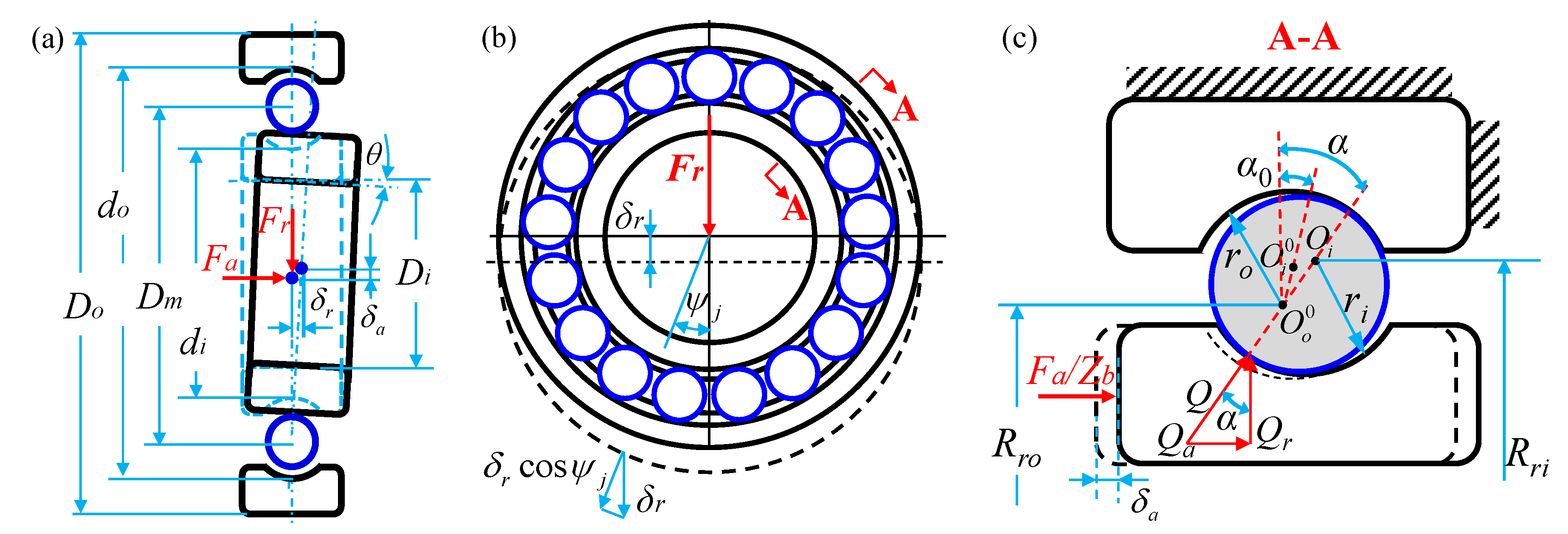
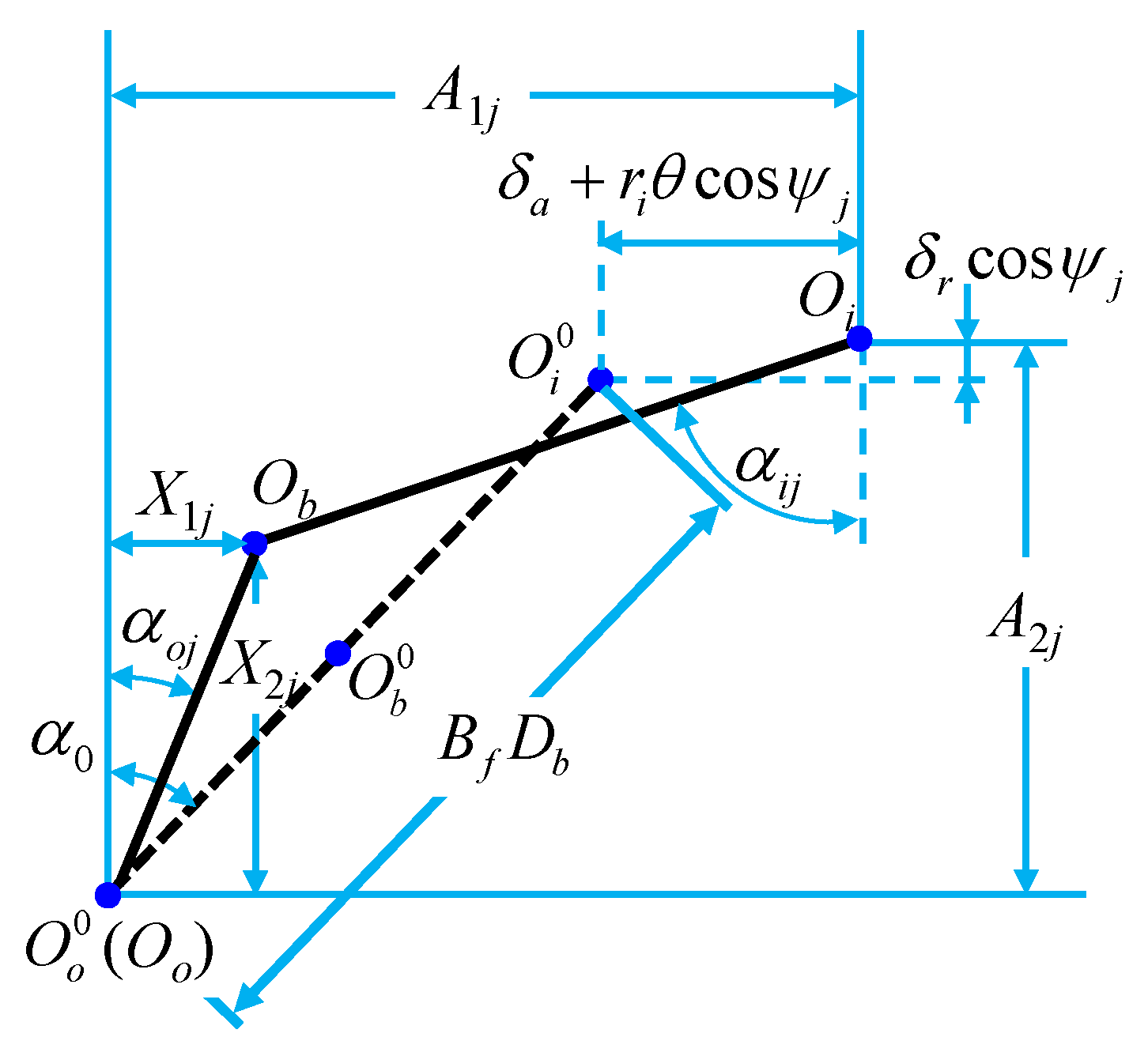

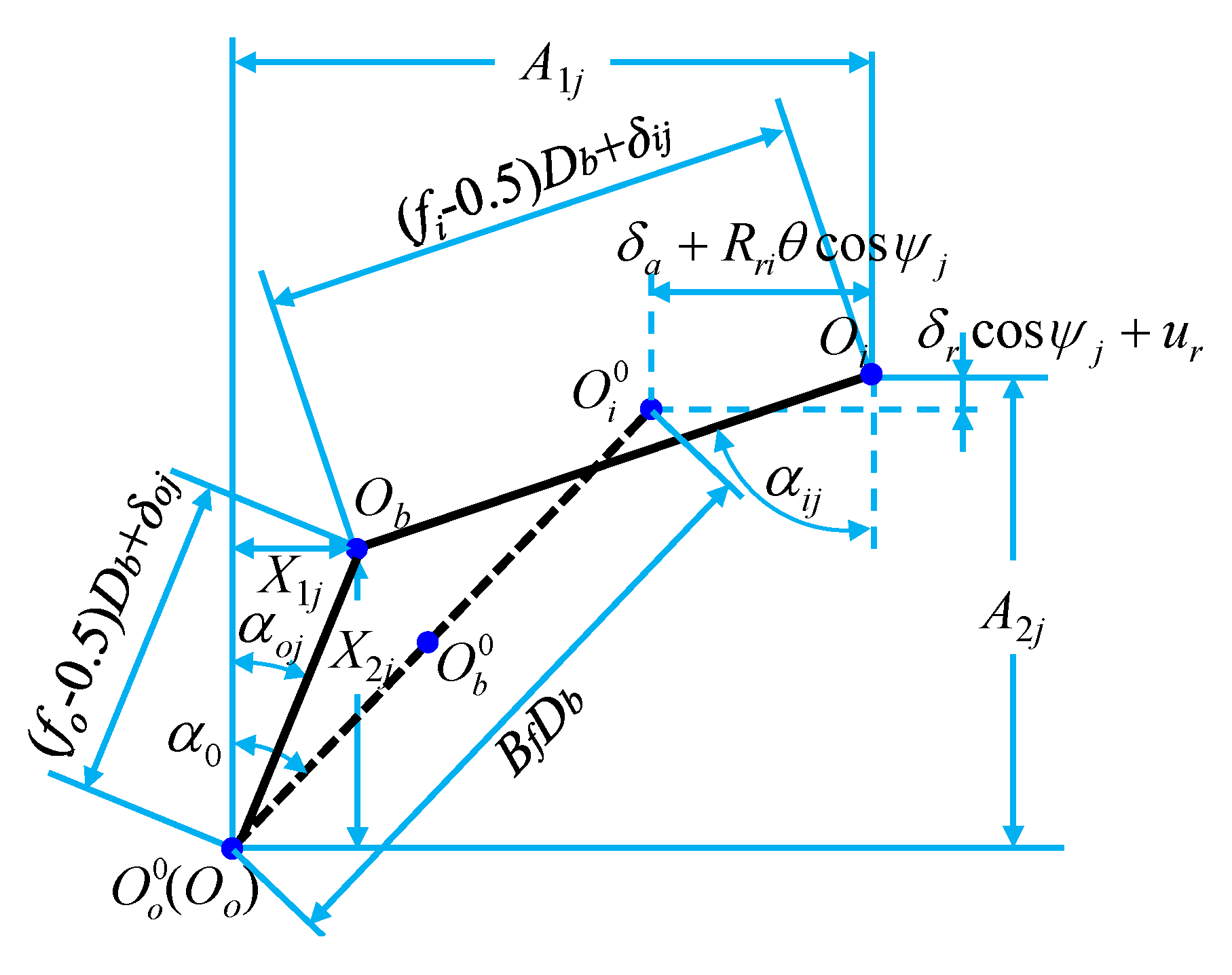
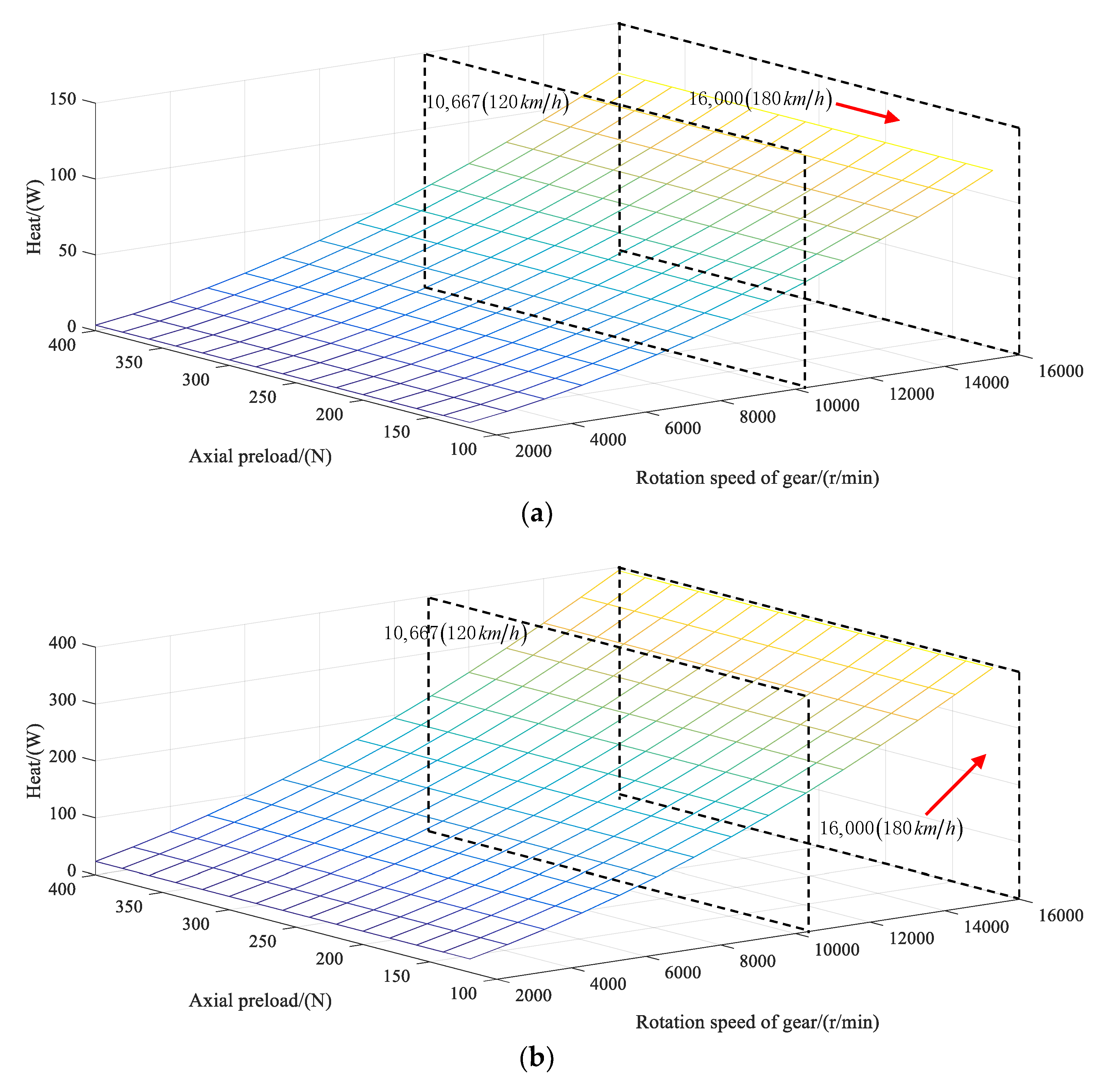
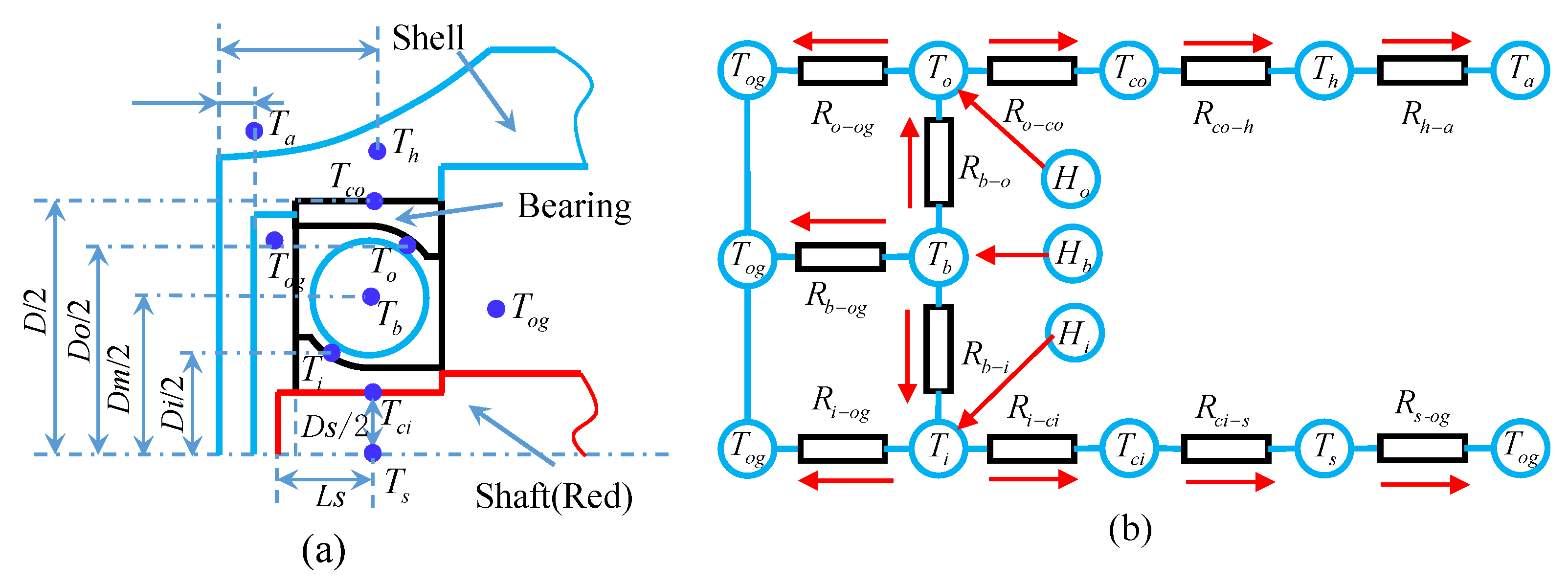
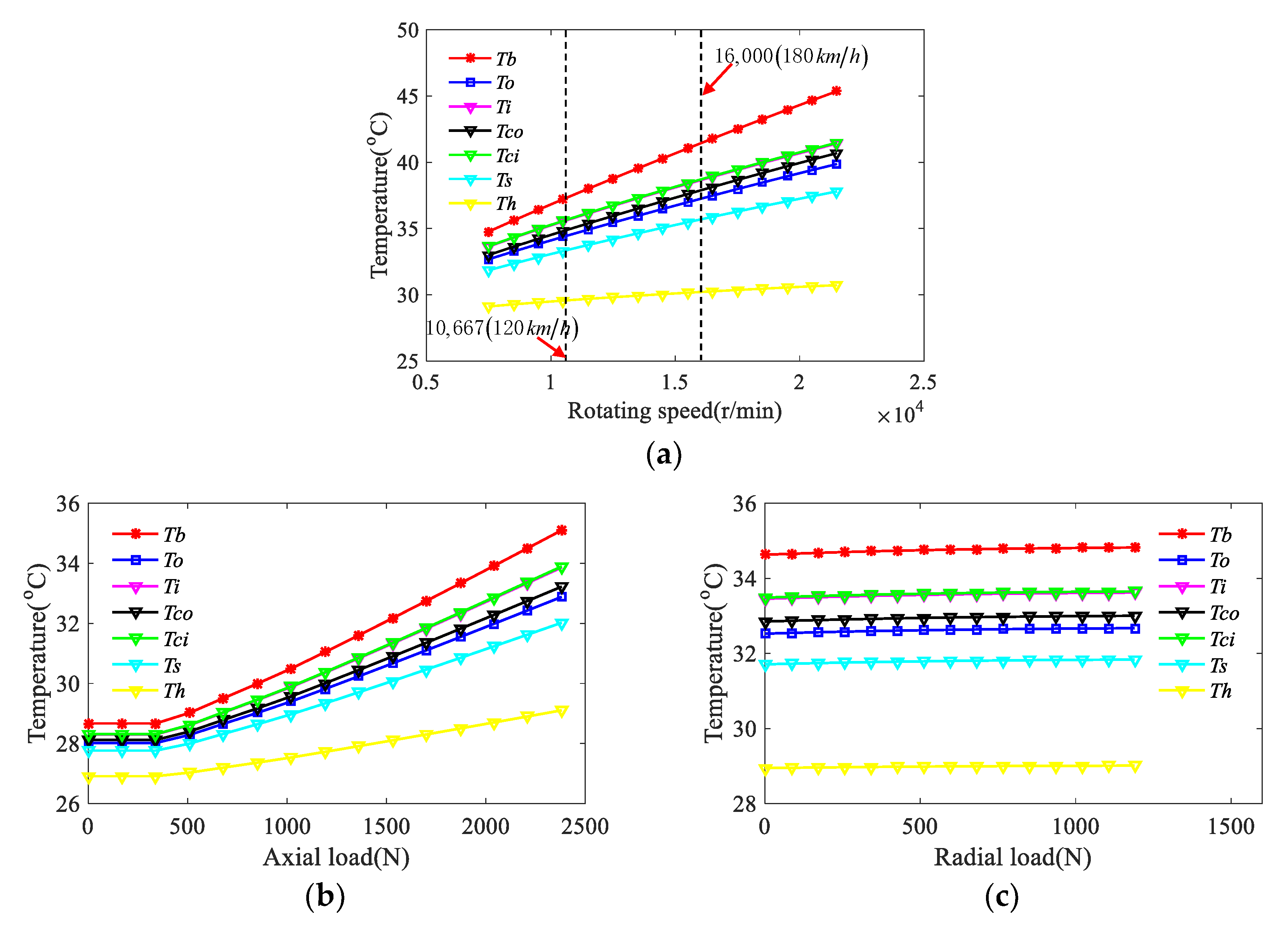

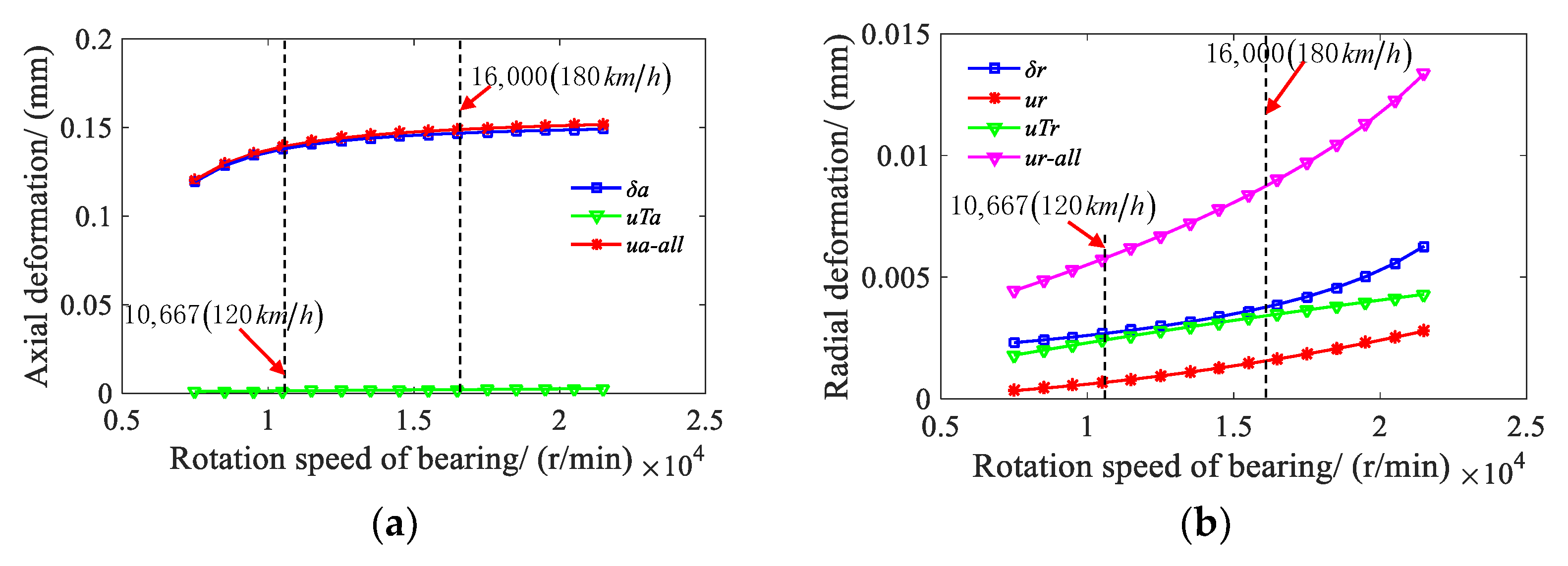

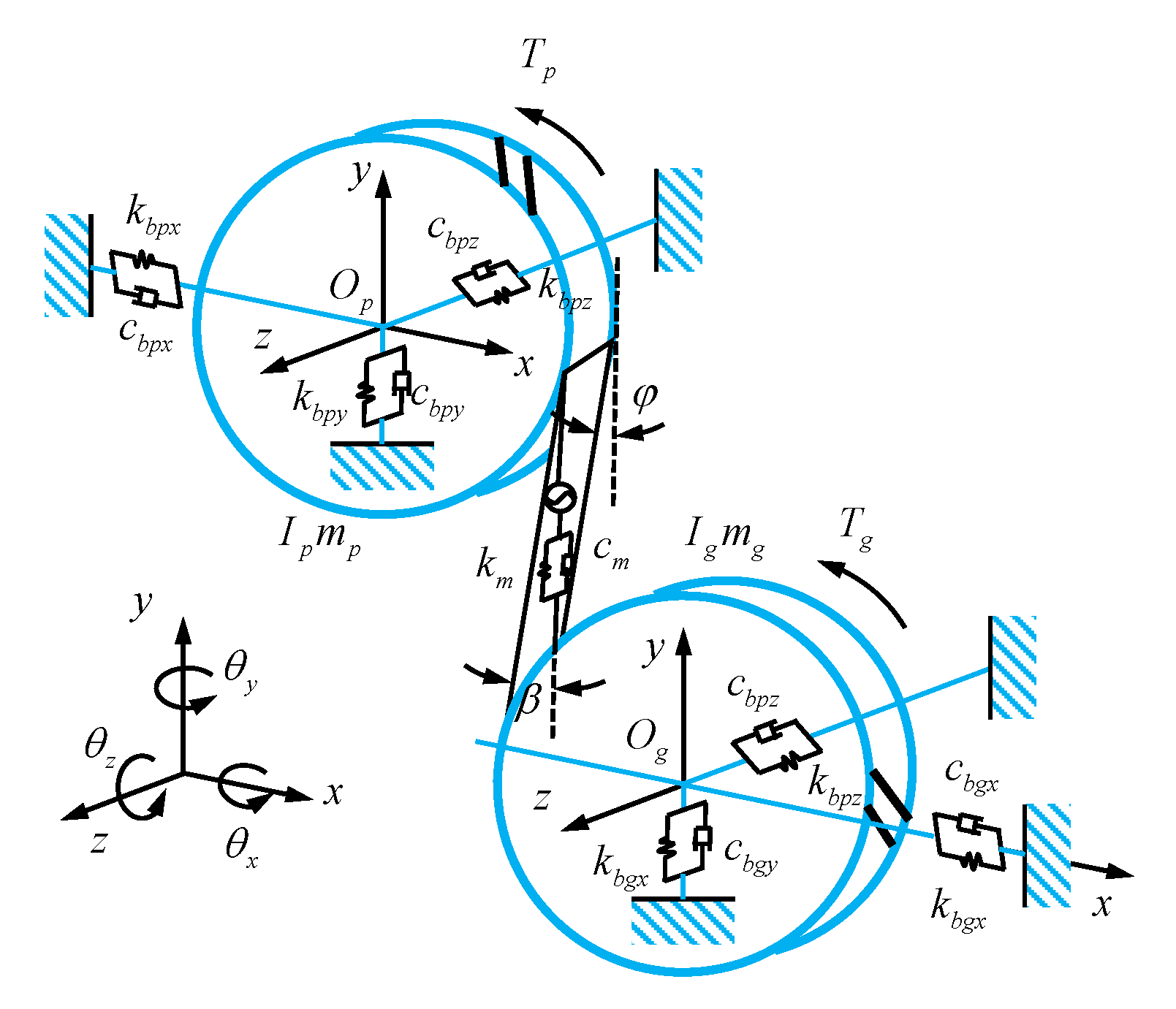

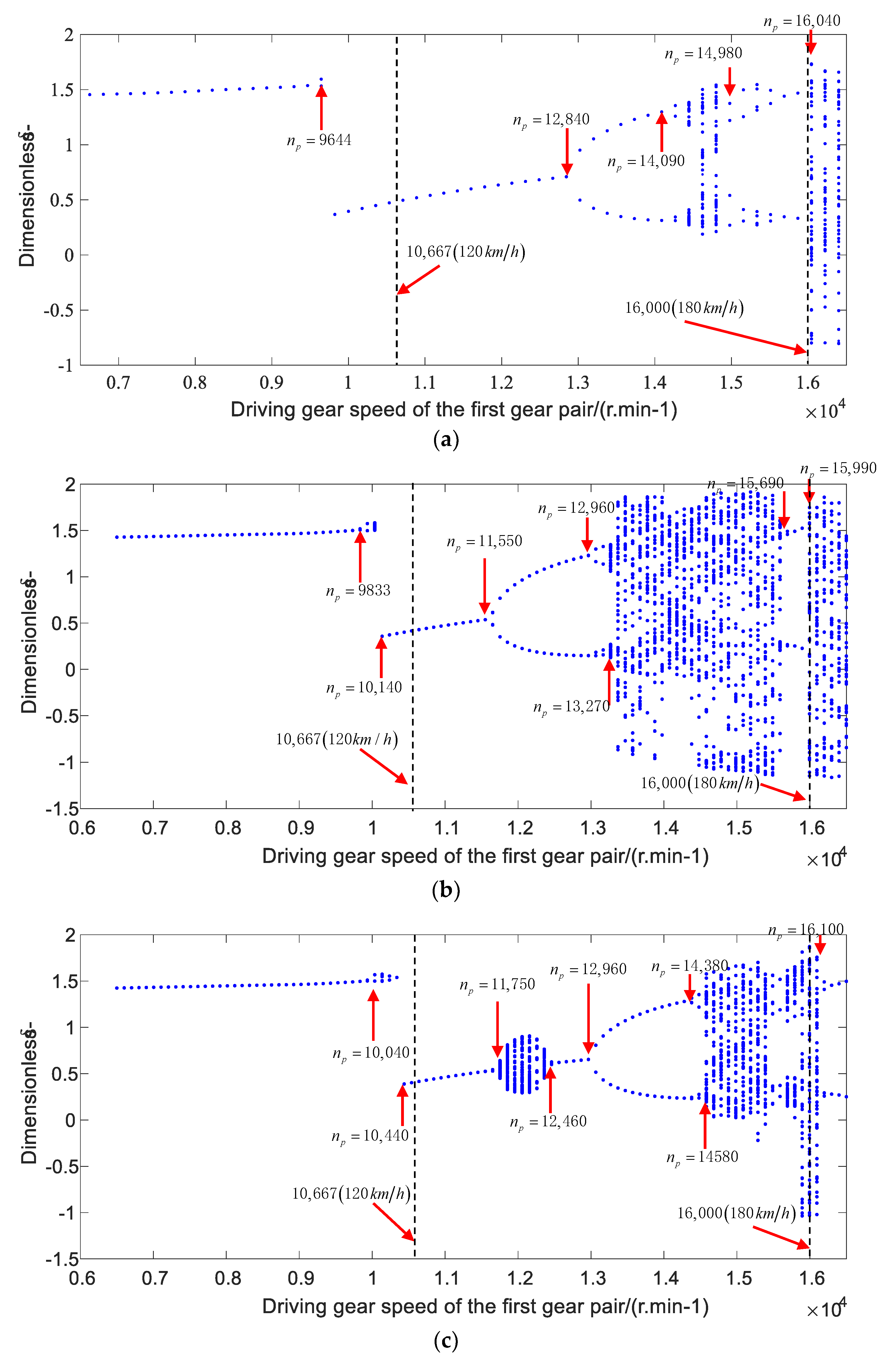
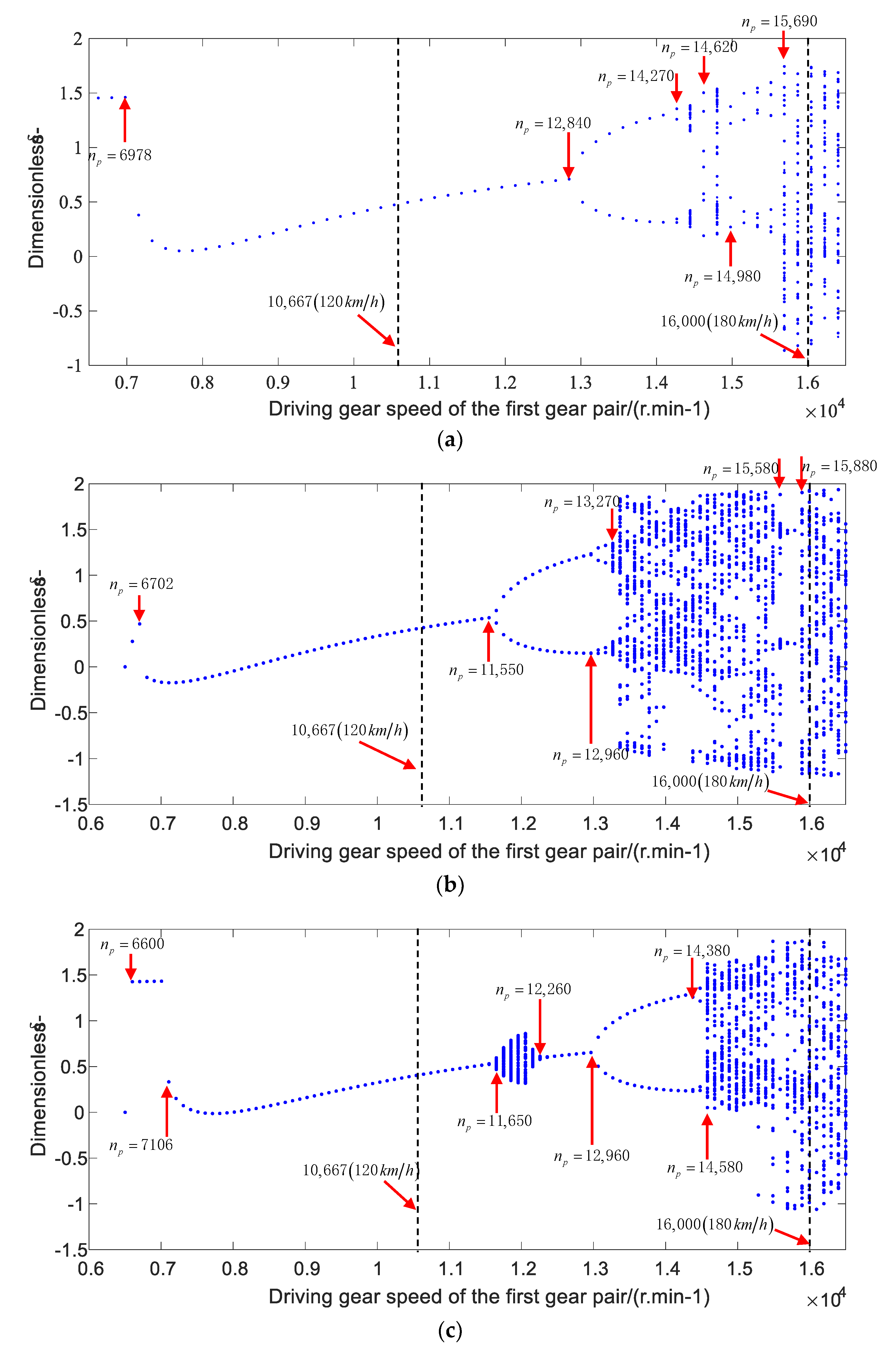
| Parameters | Deep Groove Ball Bearing |
|---|---|
| Number of balls | 9 |
| Bearing ball diameter (mm) | 12 |
| Bearing bore diameter (mm) | 40 |
| Bearing outside diameter (mm) | 80 |
| Radius of curvature of inner channel (mm) | 6.24 |
| Radius of curvature of outer channel (mm) | 6.36 |
| Coefficient of linear expansion | 1.36 × 10−7 |
| Initial contact angle (°) | 14.8351 |
| The initial clearance (mm) | 0.04 |
| Bearing pitch diameter (mm) | 60 |
| Name of the Node | Equations of the Thermal Resistance | Name of the Node | Equations of The Thermal Resistance |
|---|---|---|---|
| Rci-s | Rh-a-ax | ||
| Ri-ci | Rs-og | ||
| Rb-i | Ri-og | ||
| Rb-o | Rb-og | ||
| Ro-co | Ro-og | ||
| Rco-h | Rh-a | ||
| Rh-a-r |
| Parameters | Driving Gear | Driven Gear |
|---|---|---|
| Number of teeth | 29 | 78 |
| Normal module (mm) | 1.537 | |
| Pressure angle (°) | 16.5 | |
| Face width (mm) | 33 | |
| Helix angle (°) | 31.2 | |
| Elastic modulus (MPa) | 20,600 | |
| Material density (tonne.mm-3) | 7.8×109 | |
| Mass (kg) | 1.201 | 3.1 |
| Poisson ratio | 0.25 | |
| Rotational inertia (tonne.mm2) | 0.1152 | 1.6 |
Publisher’s Note: MDPI stays neutral with regard to jurisdictional claims in published maps and institutional affiliations. |
© 2021 by the authors. Licensee MDPI, Basel, Switzerland. This article is an open access article distributed under the terms and conditions of the Creative Commons Attribution (CC BY) license (http://creativecommons.org/licenses/by/4.0/).
Share and Cite
Liu, X.; Liu, D.; Hu, X. Influence of the Bearing Thermal Deformation on Nonlinear Dynamic Characteristics of an Electric Drive Helical Gear System. Sensors 2021, 21, 309. https://doi.org/10.3390/s21010309
Liu X, Liu D, Hu X. Influence of the Bearing Thermal Deformation on Nonlinear Dynamic Characteristics of an Electric Drive Helical Gear System. Sensors. 2021; 21(1):309. https://doi.org/10.3390/s21010309
Chicago/Turabian StyleLiu, Xianghuan, Defu Liu, and Xiaolan Hu. 2021. "Influence of the Bearing Thermal Deformation on Nonlinear Dynamic Characteristics of an Electric Drive Helical Gear System" Sensors 21, no. 1: 309. https://doi.org/10.3390/s21010309





